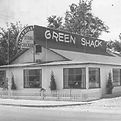
GREEN SHACK
(c.1930 - 1999)
STORY
In the early 1930s, Mattie Jones opened the Green Shack out of a newly acquired Union Pacific railroad barrack. Previously, she had been running an informal restaurant, The Colorado, out of her family home's kitchen, serving primarily friend chicken and bootleg whiskey. Her clientele was "a particular favorite [among] dam workers of the era," as it was conveniently located on East Fremont Street and Boulder Highway, on the way to Boulder Dam (later, the Hoover Dam). Jone's familiar, rural atmosphere at the Green Shack paired particularly well with the Dam's construction, as well as the legalization of "wide-open gambling" in 1931 and the loosening of marriage and divorce laws in Las Vegas. Her property was already a success by the time Prohibition ended in 1933, allowing Jones to legally sell and advertise alcohol.
The Green Shack signage notably features the word "cocktails," meaning that this sign would not have been in use before 1933. This is the oldest sign in the Neon Boneyard, and one of the oldest in the collection overall.
The Green Shack closed in 1999, asserting itself as one of the longest running restaurants in Las Vegas history. In 1994 it was listed on the National Register of History Places and is commemorated with a plaque in the location of the original building.
The signage is an example of the modest and direct style of sign design in the 1930s and 1940s. The text is the focus of the sign, incorporated in simple geographic shapes also indicative of the era.
KEY NARRATION

Sign Facts
-
The oldest sign in the Neon Boneyard, from approx. 1933-1939.
-
The Green Shack was one of the longest running restaurants in Las Vegas, remaining open until late 1999.
-
Is on National Register of Historic Places; no building anymore, but a plaque remains at the site.

Guest Education
-
Mattie Jones opens a business operating out of her kitchen window.
-
Opens as The Colorado in approx. 1929 or 1930 serving friend chicken and bootleg whiskey.
-
Relocates to a converted railroad barrack building.
-
Was popular amongst dam workers.

Additional Details
-
We know this sign couldn't have possibly existed before 1933.
-
GUEST ENGAGEMENT: Can you guess why?
-
Prohibition ends in 1933 ("Prohibition was something that happened 'somewhere else'.")